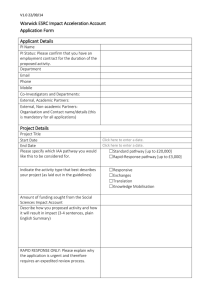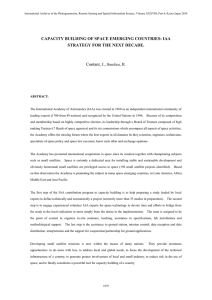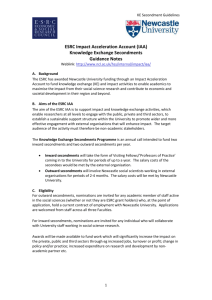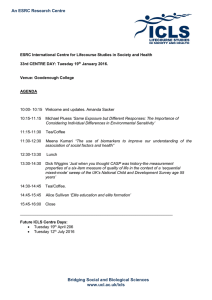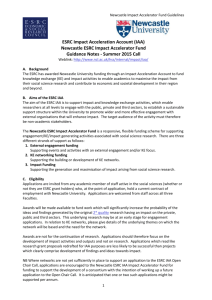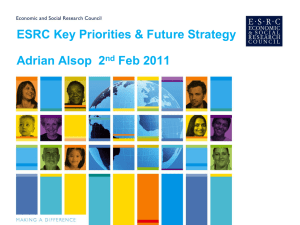ESRC Impact Acceleration Account Handbook
advertisement
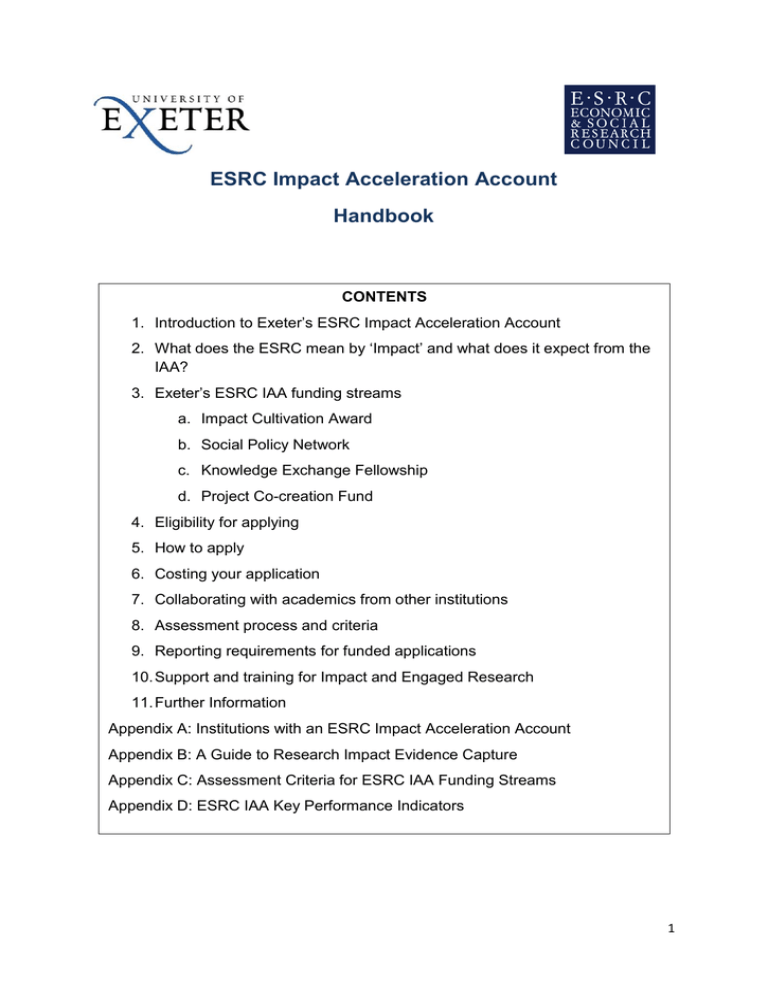
ESRC Impact Acceleration Account Handbook CONTENTS 1. Introduction to Exeter’s ESRC Impact Acceleration Account 2. What does the ESRC mean by ‘Impact’ and what does it expect from the IAA? 3. Exeter’s ESRC IAA funding streams a. Impact Cultivation Award b. Social Policy Network c. Knowledge Exchange Fellowship d. Project Co-creation Fund 4. Eligibility for applying 5. How to apply 6. Costing your application 7. Collaborating with academics from other institutions 8. Assessment process and criteria 9. Reporting requirements for funded applications 10. Support and training for Impact and Engaged Research 11. Further Information Appendix A: Institutions with an ESRC Impact Acceleration Account Appendix B: A Guide to Research Impact Evidence Capture Appendix C: Assessment Criteria for ESRC IAA Funding Streams Appendix D: ESRC IAA Key Performance Indicators 1 1. Introduction to Exeter’s ESRC Impact Acceleration Account The Economic and Social Research Council (ESRC) has awarded the University a block grant of £727k in the form of an Impact Acceleration Account (IAA); the purpose of this is to accelerate the non-academic impact of existing social sciences research. This replaces previous ESRC follow-on funding schemes, and has allowed the University to provide a more flexible and responsive approach to supporting impact from social sciences research through internally allocated funding streams. The University of Exeter is one of 24 institutions nationally to have been awarded an ESRC IAA (for the other institutions see appendix A). The overall aims and objectives of the Exeter ESRC IAA are to: (i) (ii) (iii) Create opportunities for University of Exeter social science researchers to maximise the social and economic benefit of their research through collaboration with nonacademic partners (e.g. business, industry, health sector, community-based organisations, etc.) Facilitate the creation of networks and contacts between University of Exeter social scientists and research users and agencies outside of the academic sector. Promote social and economic benefit of research as an important element within the design and creation of research programmes amongst the University of Exeter’s social science researchers. Exeter’s ESRC IAA is managed and run by a team which consists of: Professor Robert Gleave (Professor of Arabic Studies) - academic PI and project lead of the ESRC IAA Emma Roberts - ESRC IAA Project Co-ordinator Claire Packman (Research Impact Manager in Research Services) – Communications lead 2. What does the ESRC mean by ‘Impact’ and what does it expect from the IAA? Although the IAA is operated by the University, the ESRC has clear expectations regarding ‘impact’. The ESRC definition of impact is 'the demonstrable contribution that excellent research makes to society and the economy'. Research impact embraces all the diverse ways that research findings and research-related skills benefit individuals, organisations and nations. These include: fostering global economic performance, and specifically the economic competitiveness of the United Kingdom increasing the effectiveness of public services and policy enhancing quality of life, health and creative output. A key aspect of the ESRC definition of impact is that it must be possible to demonstrate the impact that research has had; it is not enough just to focus on activities and outputs that promote research impact. You must be able to provide evidence of research impact, for example, that it has been taken up and used by policymakers and practitioners, or has led to improvements in services or business. Some of the core conceptualisations that the ESRC uses to demonstrate the type of outcomes they expect from the IAA are: 2 impact that is instrumental (influencing the development of policy and practice) impact that is conceptual (shifting understanding around issues and changing the way problems are understood), culture change and enduring connectivity (more people working across the academic/ non-academic divide and building lasting relationships). For more information about impact in the ESRC, see the ESRC’s ‘Impact Toolkit’: http://www.esrc.ac.uk/funding-and-guidance/impact-toolkit/ 3. Exeter’s IAA Funding Streams At Exeter the IAA offers four distinct funding streams which support impact in different ways and at different stages of development. This is designed to act as a ‘ladder’ from early-stage development of a collaborative idea with a non-academic partner organisation or policy group (Cultivation Award and Social Policy Networks) through to in-depth engagement (Project Cocreation and Knowledge Exchange Fellowships). Funding Stream Funding available Frequency of deadlines Current Application Deadlines Impact Cultivation Awards up to £3,000 4 per year 6 April 2016 4 July 2016 28 September 2016 Social Policy Networks up to £3,000 4 per year Project Cocreation Fund up to £20,000 2 per year Knowledge Exchange Fellowships up to £20,000 2 per year 6 April 2016 28 September 2016 (NB: Last call) Key features of successful applications to these schemes will be that they: build on the existing social sciences research findings of the principal applicant (although it may draw on the research of others too, e.g. colleagues, PhD students). It is essential that this research has already been undertaken, and falls within the ESRC research remit (for further information about this see: http://www.esrc.ac.uk/about-esrc/what-is-socialscience/) involve working with a non-academic partner organisation – this should include a commitment from the partner(s) for either match or in-kind funding, with a higher level expected for the higher levels of funding. We recognise that not all partners necessarily have equal resources to do this, and this will be taken into account when applications are assessed, but match- or in-kind funding may be viewed as an indication of an equitable partnership to which all stakeholders are committed. 3 plan effective knowledge exchange activities which maximise the level of engagement with the partner organisation. These must be outlined in detail in the application. indicate the type of impact that may emerge from the project and outline what evidence of they will collect to demonstrate this (see appendix B) The following outlines the key features of each of the four funding schemes. Detailed assessment criteria for each scheme are available in appendix C. a. Impact Cultivation Award Aims and objectives: This award is to enable UoE social scientists to initiate and develop contacts and networks with potential collaborators from beyond the academic sector, and to create new ventures through which these external partnerships might be further developed to facilitate knowledge exchange and the creation of impact. Indicative activities: It is envisaged that this funding will support small-scale activities, such as workshops, meetings, the translation of findings, and development of frameworks. These activities should be to explore how the potential social and economic benefit of existing and ongoing research might be realised, or to devise a plan for realising impact. Funding amount: Up to £3,000 Intended length of project: Up to 6 months b. Social Policy Networks Aims and objectives: This stream provides an opportunity for UoE social scientists to establish a network of policy officials and academics with policy experience. The aim of these networks should be to create and develop knowledge exchange opportunities through which the potential social and economic benefit of the research for policy can be explored. Indicative activities: An event or programme of events through which new networks can be formed or existing networks of researchers and policy-related partners in the non-academic sector can be strengthened. Funding amount: Up to £3,000 Intended length of project: Up to 6 months c. Knowledge Exchange Fellowships Aims and objectives: To deepen existing links between UoE social science researchers and non-academic bodies through short-term staff placements, either from the University out to the external partners or vice-versa. KE Fellows will act as change agents, enabling the free flow of knowledge and expertise between the University and partner organisations, thus accelerating impact. Indicative activities: The core activity will be co-creational research carried out on placements. Within this mode of collaborative working, activities may include: research design, the development of methodology, and interpretation and presentation of findings, as well as data development or the translation of existing research findings. This funding can be spent on academic salary costs, travel and subsistence, and impact events such as symposia. 4 Fellowships are for between 3 and 12 months and can be organised in flexible blocks of time to suit the participants and nature of the project. Partner contribution and letters of support: It is expected that partners will also make a significant contribution to the Fellowship, in cash or in kind. In-kind contributions will include staff time, access to equipment, provision of materials or other items. We request that a letter of support from the partner is submitted with the application. A collaboration agreement detailing this must be in place prior to the project starting. Funding amount: Up to £20,000 Intended length of project: Up to 1 year d. Project Co-Creation Fund Aims and objectives: This stream enables a collaborative approach with one or several nonacademic partners to the exploration, development and implementation of findings from UoE research. It aims to generate significant social or economic benefits through co-created outputs. Projects should deepen existing relationships between UoE social scientists and external partners with a view to creating wider benefit over the long term. Indicative activities: A project through which co-created research or other outputs (for example, a toolkit, training programme, policy framework, intervention project, etc.) are produced. This funding can be spent on academic salary costs, a Research or Project Assistant (e.g an existing or recent PhD student), travel and subsistence, impact events such as symposia, or on specialist services (e.g. a mobile app designer). Partner contribution and letters of support: It is expected that partners will also make a significant contribution to the project (in cash or in-kind). In-kind contributions will include staff time, access to equipment, provision of materials or other items. We request that a letter of support from the partner is submitted with the application. A collaboration agreement detailing this must be in place prior to the project starting. Funding amount: Up to £20,000 Intended length of project: Up to 1 year 4. Eligibility In order for applications to be eligible for ESRC IAA funding: The Principal Applicant must be employed by the University of Exeter on a research contract until at least the end-date of the project The application must have the support of the Associate Dean of Research The proposal must be focused on creating impact from the existing social sciences research of the Principle Applicant. The IAA is not pump-priming for new research, i.e. it is not about creating new partnerships to be used in the application for external research funding. The following are ineligible for support through IAA funding: Large ESRC investments (e.g. Centres, Large Grants, Infrastructure Investments) during the term of funding. These should already have significant funding for impact through the ‘Pathways to Impact’ part of the bid. 5 Impact activities which may already be included within an-ESRC funded project. If your application builds on an ESRC project which is still live or has only recently ended then we seek reassurance that the IAA application extends rather than replicates the work of the existing project. Basic research that does not include substantive user engagement Knowledge Transfer Partnerships (KTPs). Postgraduate research students. N.b. There may be other forms of funding available for postgraduate research students so please contact the Researcher Development Team (ResearcherDevelopment@exeter.ac.uk) to find out more about these. 5. How to apply 1. Download the application form for the appropriate funding stream from the Internal Funding Opportunities page of the Research Toolkit on the University of Exeter intranet: http://www.exeter.ac.uk/research/toolkit/opportunities/internalopps/ 2. Complete the application form. Please ensure typesize is no smaller than (Arial) 11pt. If applications exceed the permitted length they will be returned to you to be edited down, proximity to deadline permitting. If time does not permit, only the first 4 or 6 pages may be sent to reviewers. 3. Include a full costing of your project from your usual Research Administrator (to include any non-costed time you will spend on the project and the match or in-kind contribution from your partner organisation(s)) 4. Obtain a Statement of Support from external collaborators for Project Co-creation and Knowledge Exchange Fellowship funding, outlining their agreement to participate and details of any match funding or in-kind contribution 5. Obtain application sign-off from your Associate College Manager for Research and your Associate Dean of Research 6. Submit application to ESRC-IAA@Exeter.ac.uk by your chosen deadline (see table 1, above) 6. Costing your application All costings must be calculated or checked by your pre-award Research Administrator to ensure accuracy and compliance with College protocol, and must then be signed off by your Assistant College Manager for Research. The following guidance applies to these costs: The ESRC IAA can fund direct costs only, which may include, for example, travel and subsistence, venue hire, staff costs (including the use of a Research or Project Assistant if appropriate), and external contractors for specialist tasks (e.g. design work). Estates and overheads are not eligible for funding from the ESRC IAA. All costs must be stated with the inclusion of VAT. This is especially important where this will be payable from the IAA funding. Due to the expectation of match or in-kind funding from the partner organisation(s), these match and/or in-kind costs should be indicated in the application, as should any costs that are being supported by the College (which may primarily be staff time that is not being requested from the IAA funding). It is important that these are fully included not only because this will be considered as part of the review process, but also because they will be included in our reporting to the ESRC if your application is successful. 6 N.b. support may be available from RKT to assist with organising events and meetings but please specifically state any support that might be required in your application. The Principal Applicant will be responsible for ensuring proposed activities are completed and all costs charged by the agreed project end date at the latest, and for reporting on outcomes (see below). 7. Collaborating with academics from other institutions Although the central aim of any application to the IAA should be to work with non-academic partners, the often collaborative nature of research means that some projects may additionally involve academic collaborators from institutions other than Exeter. If this is the case the academic(s) from other institutions may be included on the bid as a co-applicant; however staff costs for this applicant cannot be paid from the IAA funding and should be a match contribution from the collaborating institution. Where this institution has an ESRC IAA (see appendix A) this might be a suitable source for funding these staff costs, depending on the specific details of that IAA scheme. Exeter has a formal arrangement with GW4 ESRC IAA institutions, so if your collaborator(s) are from either Bristol or Cardiff universities please contact the Exeter IAA team for details. 8. Assessment process and criteria All applications will receive two reviews from our ESRC IAA Assessment College, which includes Exeter academics with strong impact experience and external, non-academic assessors who work in relevant sectors. In addition to identifying whether applications fulfil the eligibility criteria above, applications will be assessed on the extent to which: The application aims to exploit existing research The project demonstrates engagement with at least one external, non-academic stakeholder (this might take into account leverage, statement from the partner, the activities being proposed) The application details specific areas of work: who, what, where and when The anticipated outcomes are aligned with the funding stream’s aims The application has a clear and feasible delivery and project plan with realistic milestones and outcomes The application details how the impacts will be recorded and monitored The proposed work is feasible within the given timeframe The resources requested are justifiable Please see Appendix C for the specific criteria for each of the four funding streams. You will be notified of the outcome of your application to the Cultivation and Social Policy Network streams within three weeks of the deadline, and to the Project Co-Creation and Knowledge Exchange Fellowship streams within five weeks of the deadline. 7 9. Reporting requirements for funded applications The Principal Applicant of each project funded will be required to contribute to the University’s report to the ESRC on the activities carried out, outcomes and impacts (or expected future impacts), specifically: A short summary of the activities conducted, opportunities identified and future plans. A report of the tangible benefits and successes achieved or likely to be realised after the project, by both the user (and their potential beneficiaries) and the University. This includes indicators of success, such as number of new connections and partnerships (defined as involving an exchange of resources – e.g. co-funding, leverage, and contributions in kind), projects started, numbers participating in events. A member of the ESRC IAA team may also follow up several months after the project to find out about longer-term impacts. The ESRC has produced a table of the Key Performance Indicators it expects to see from IAAs as a whole. Some of these indicators may be relevant to your project (see appendix D). We will also feature projects in publicity and on the website as an important part of the sharing of good practice and news about impact within the University and beyond. For this reason one of the conditions of funding is that the Principle Applicant complies with requests for information about the project for these materials. We will always obtain permission on project specific information before publishing. 10. Support and training for impact and engaged research Both the ESRC and the University of Exeter recognise that the concept of ‘research impact’ is relatively new. In light of this, support and training is available through a number of different routes: The UoE online Research Toolkit (http://www.exeter.ac.uk/research/toolkit/) has a range of information, from general information about impact, through how to collaborate with partners, to managing Intellectual Property and the commercialisation of research. The ESRC Impact Toolkit (http://www.esrc.ac.uk/funding-and-guidance/impact-toolkit/) provides comprehensive guidance on maximising the impact from research. This also contains many examples of impact from the social sciences. Research and Knowledge Transfer staff offer a range of professional services relating to knowledge transfer, engagement and impact. The ESRC IAA team will be happy to help direct academics to this specialist support, or details can be found on the webpages: http://www.exeter.ac.uk/research/rkt/contact/staff/ The Impact and Engaged Research Network (launched in January 2015) is open to all academic and professional services staff. The network meets monthly with a range of different events, including training and sharing of best practice. Please contact the ESRC IAA team to be added to the mailing list. Details of network events can be found on the Research Events webpage: http://www.exeter.ac.uk/research/events/ Bespoke social sciences impact training is part of the wider remit of the ESRC IAA, and will be made available through the life of the IAA where a need has been identified. Details will be circulated by email and included in staff e-newsletters, and will also be listed on the Research Events webpages, above. 8 11. Further information Further information is available on Exeter’s ESRC IAA webpages: http://www.exeter.ac.uk/research/inspiring/impact/iaa/ If you have any questions about the ESRC Impact Acceleration Account, please contact the IAA Project Co-ordinator, Emma Roberts (ESRC-IAA@exeter.ac.uk). If you have more general questions relating to impact, please contact Research Impact Manager Claire Packman (c.h.packman@exeter.ac.uk). 9 Appendix A: Institutions with an ESRC IAA 2014-2018 Cardiff University Durham University Imperial College London Institute of Fiscal Studies King's College London LSE Newcastle University University of Bangor University of Birmingham University of Bristol University of Cambridge University of East Anglia University of Edinburgh University of Essex University of Exeter University of Glasgow University of Manchester University of Nottingham University of Oxford University of Sheffield University of Southampton University of Sussex University of Warwick University of York 10 Appendix B: A Guide to Research Impact Evidence Capture The Research Councils UK (RCUK) defines impact as ‘the demonstrable contribution that excellent research makes to the economy and society’. As such, researchers and universities are required by their funders to report on and provide evidence of research impacts. At the University of Exeter RKT are available to advise on and support the capture of this evidence, but researchers themselves are generally best placed to capture and record this information themselves. The aim of this guide is to help you to identify the type of evidence that would be most relevant to capture for your own impact activities. Very few of these pieces of evidence indicate impact on their own – they must be gathered in combinations that demonstrate: The reach (breadth) and the significance (importance) of the impact. The specific relationship between the research and the impact being claimed. Some of these types of capture must be planned in advance (e.g. evidence for events) and so it should be planned at the conception of the research project and pathways to impact, but it will likely be useful to review the plans at a later point as they evolve, and also periodically after the end of your activities to consider whether there might be ongoing impact outwith your involvement. General information relevant to a range of engagement/impact activities: Names and contact details of external partners / stakeholders/ user organisations /policy makers etc. (Keep a record of these, remember to save business cards or delegate lists) Independent, authoritative statements about the impact from external partners/ stakeholders/ user organisations/policy makers/independent experts (secure these whilst they are fresh, consider updating them when new evidence comes to light, check whether you have approval for them to appear in the public domain) Records of communications requesting expertise or demonstrating knowledge exchange e.g. Emails demonstrating the nature of the knowledge exchange that has taken place Dates of external meetings / presentations (consider keeping an ‘impact diary’ or ensure that meetings and details are archived in Outlook) Memberships of advisory boards Details of funding from public or charitable bodies (Such as amount, dates, letters of support) List of patents and licence agreements If you are holding an event, information to record includes: Numbers and details (where relevant) of individuals attending impact-relevant external events (workshops, training (e.g. CPD), public lectures, seminars, exhibitions, performances etc.) Records of school visits / public engagement activities (include number of attendees, possibly also diversity, age mix etc.) Feedback and evaluation from external participants to indicate whether there has been a change in understanding and what this might then lead to – for example a change in behaviour or vision (For example, this might be done through evaluation forms, video or audio recordings, written feedback – if funding is available then this could be carried out by an external evaluator) Copies of programme, exhibition or catalogue notes 11 Depending on the type of participants and the potential for longer-term, future impact, you may want to record the names and contact details of participants so that you can follow up with each to gain further feedback/evaluation some months/years after the event. Evidence to capture on media coverage and social media interactions: Archiving of press (print and web-based) coverage of research or impact such as news clippings, TV slots etc. e.g. of directly placed articles/engagement, critical reviews, coverage of policy change Archiving of comments on press coverage Colleges may consider this to be something that the Press Office can do Archiving of blog posts and social media, particularly where there has been online interaction/conversation through this Numbers of viewers/listeners of TV and radio broadcasts (e.g. from RAJAR) Numbers of downloads or website hits If you engage with/have impact on policy or professional practice evidence may include: Professional/practice documents citing research or where the research has been influential and contact details or a statement from an external author corroborating this influence. Policy/practitioner documents citing work Reference to the research in policy discussion (e.g. Hansard) Data from clinical trials detailing improved patient outcomes (for example, a reduction in symptoms; increased mobility; similar or improved outcomes but with a reduction in the cost of treatment; reduction in the length of hospital stay or treatment programme) The number of medical professionals using a particular technique, or number of times used and details about how this has been beneficial or improved patient care Numbers of downloads of documents or other media and details of those who have downloaded it Number of website hits If you engage with/have impact on businesses or are involved in commercialisation: Numbers of sales of a specific product – quantity and value Business performance measures – turnover, profit, number of employees Number of jobs created or protected Amount of investment funding raised (e.g. venture capital) for start-ups or new activities of existing businesses Licences brought to market – documentation of the licence Numbers of downloads of software or IP, and details of those who have downloaded the item Number of website hits 12 Appendix C: Assessment Criteria for ESRC IAA Funding Streams a. Impact Cultivation Award Applications will be assessed against the extent to which: The application aims to exploit existing research of the Principal Applicant The project proposes high quality knowledge exchange activities with at least one non-academic stakeholder (this might take into account any statement from the partner and/or leverage or in-kind match) The activities proposed will enable the applicant(s) to develop new relationships with potential nonacademic partners to explore the potential (and develop a plan) for creating impact The application details a specific programme of work The project has a clear and feasible delivery and project plan with realistic milestones and target outcomes The application details how the outcomes will be recorded and monitored The resources requested are adequately and appropriately justified b. Social Policy Network Applications will be assessed against the extent to which: The application aims to exploit existing research of the Principal Applicant The project proposes high quality knowledge exchange activities with a number of policy-relevant stakeholders (this might take into account any statement from the partner and/or leverage or in-kind match) The activities proposed will enable the applicant(s) to develop a network with non-academic policy partners to explore the potential (and develop a plan) for impact on policy The application details a specific programme of work The project has a clear and feasible delivery and project plan with realistic milestones and target outcomes The application details how the outcomes will be recorded and monitored The resources requested are adequately and appropriately justified c. Project Co-Creation Fund Applications will be assessed against the extent to which: The project aims to exploit existing research of the Principal Applicant The project aims to create research through a partnership of the academic and the external partner The application details a specific set of activities, setting out responsibilities of the applicant(s) and of the project partner(s) for each The project involves the non-academic partner in the proposed activities (i.e. the extent to which all aspects of the project will be ‘co-created’) 13 The project partner(s) are making a cash or in-kind contribution to the project (e.g. staff time, workspace or other resources), or justification if this is relatively small The resources requested are clearly and robustly justified The project has a clear and feasible delivery and project plan with realistic milestones and target outcomes The application details how the outcomes will be recorded and monitored The application clearly identifies the social and/or economic impacts (benefits) that are expected to result from the project, and how these will be captured d. Knowledge Exchange Fellowship Applications will be assessed against the extent to which: The project aims to exploit the existing research of the Principal Applicant The project consists of high quality knowledge exchange activities with at least one non-academic stakeholder and details how the placement will enable sharing and embedding of expertise The project partner(s) are making a cash or in-kind contribution to the project (e.g. staff time, workspace or other resources), or justification if this is relatively small The resources requested are clearly and robustly justified The application details a specific set of activities, setting out responsibilities of the applicant(s) and of the project partner(s) The project has a clear and feasible delivery and project plan with realistic milestones and target outcomes The application details how the outcomes will be recorded and monitored The application clearly identifies the social and/or economic impacts (benefits) that are expected to result from the project, and how these will be captured 14 Appendix D: ESRC IAA Key Performance Indicators Activity (including) Secondments, Placements, Visits1 Reporting must include information on the sector of the non-academic partner (and the size of corporate partners) Outputs (including) Number of secondment projects (inward/outward) Cash and in-kind contributions from nonacademic partners Joint publications with non-academic partners Early Stage Commercialisation This can include social enterprise, joint ventures and spin outs Number of patents filed and disclosures received Number and value of licensing agreements Number of Proof of Concept (PoC) projects Value of co-produced research Number of market assessments completed Number of prototypes/ tool kits/ test beds/ beta software produced Number of CPD Programmes developed Outcomes (including) Number of partners who go on to pursue further collaborations with RO following secondment/ placement/ visit Investment in further engagement following secondment Future employment destination of secondee or others from the RO Investment gained in activity Number of spin-outs/ social enterprise/ joint ventures established External investment in spin-outs/ social enterprise/ joint ventures Number of PoC projects funded by others Licenses completed Income generated (included through consultancy fully funded by non-academic organisation) Extent and reach of CPD Programmes Increase in range of research investors in the RO Increase in research investment and engagement with non-academic organisations Increase in the number of projects that continue beyond initial engagement Increase in volume and value of collaborative activities (e.g. Innovate UK, KTP etc) Number of collaborative projects supported by IAA (and number not supported) Agility and rapidity of funding for time-bound activity Number of new partners participating in collaborative projects/ proposals Number of new collaborative projects/proposals following engagement through IAA funding Cash and in-kind contributions from partners Number of industry visits Number of strategic events participated in (both ways) Joint publications (academic and other) with non-academics 1 With a visit being less formal than the others, but an engagement that is part of relationship, project or capacity building User Engagement Reporting must include information on the sector of the non-academic partner (and the size of corporate partners) Impacts (including) Jobs and/or increased turnover, profit and exports from/of new products and/or processes Policy and/or practice change Increased R&D expenditure of non-academic partner Jobs and/or increased turnover, profit and exports from/of new products and/or processes New business models in non-academic organisations Cost savings in non-academic organisations Policy and/or practice change Jobs and/or increased turnover, profit and exports from/of new products and/or processes Increased R&D expenditure of non-academic partner New business models in non-academic organisations Cost savings in non-academic organisations Policy and/or practice change 15
